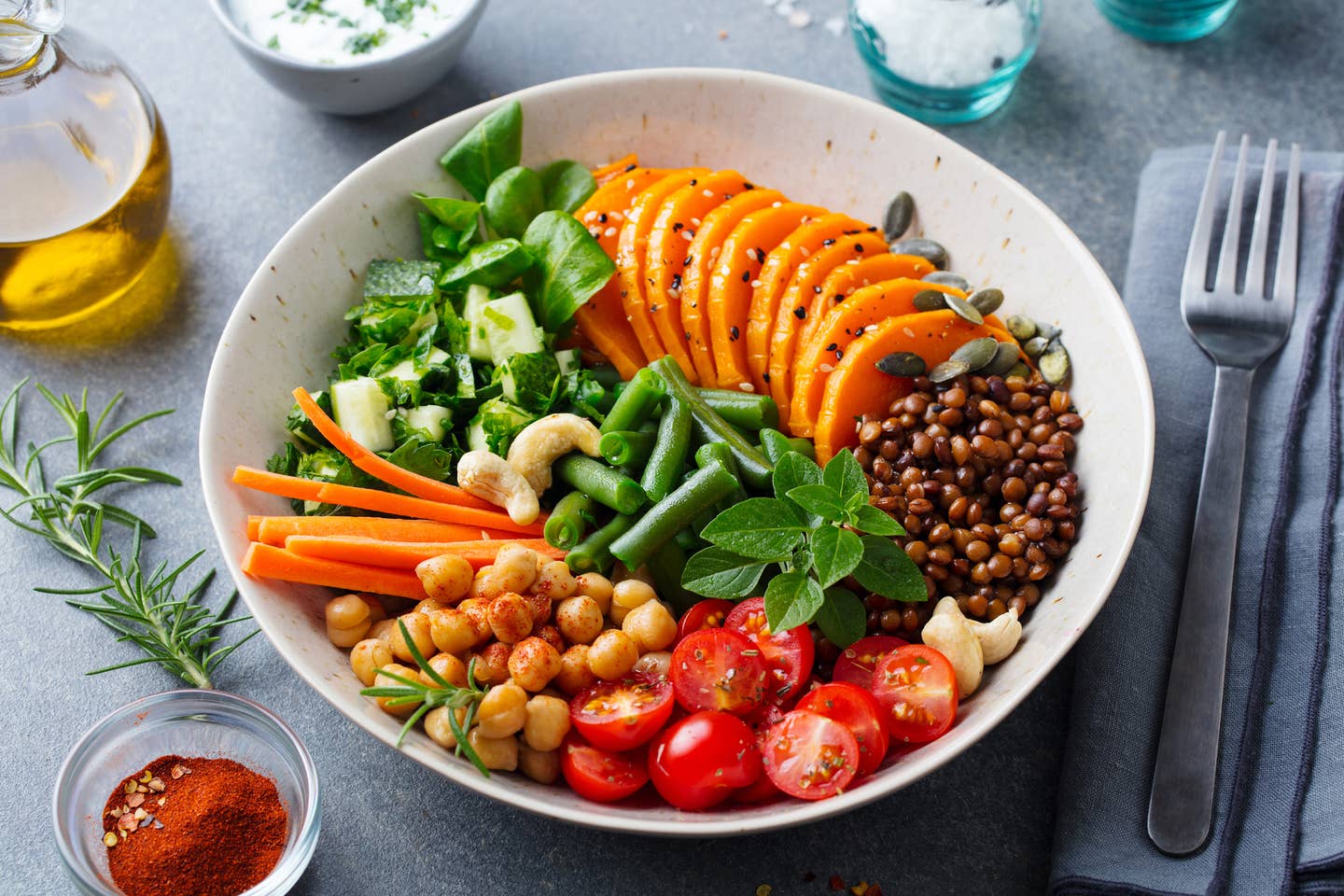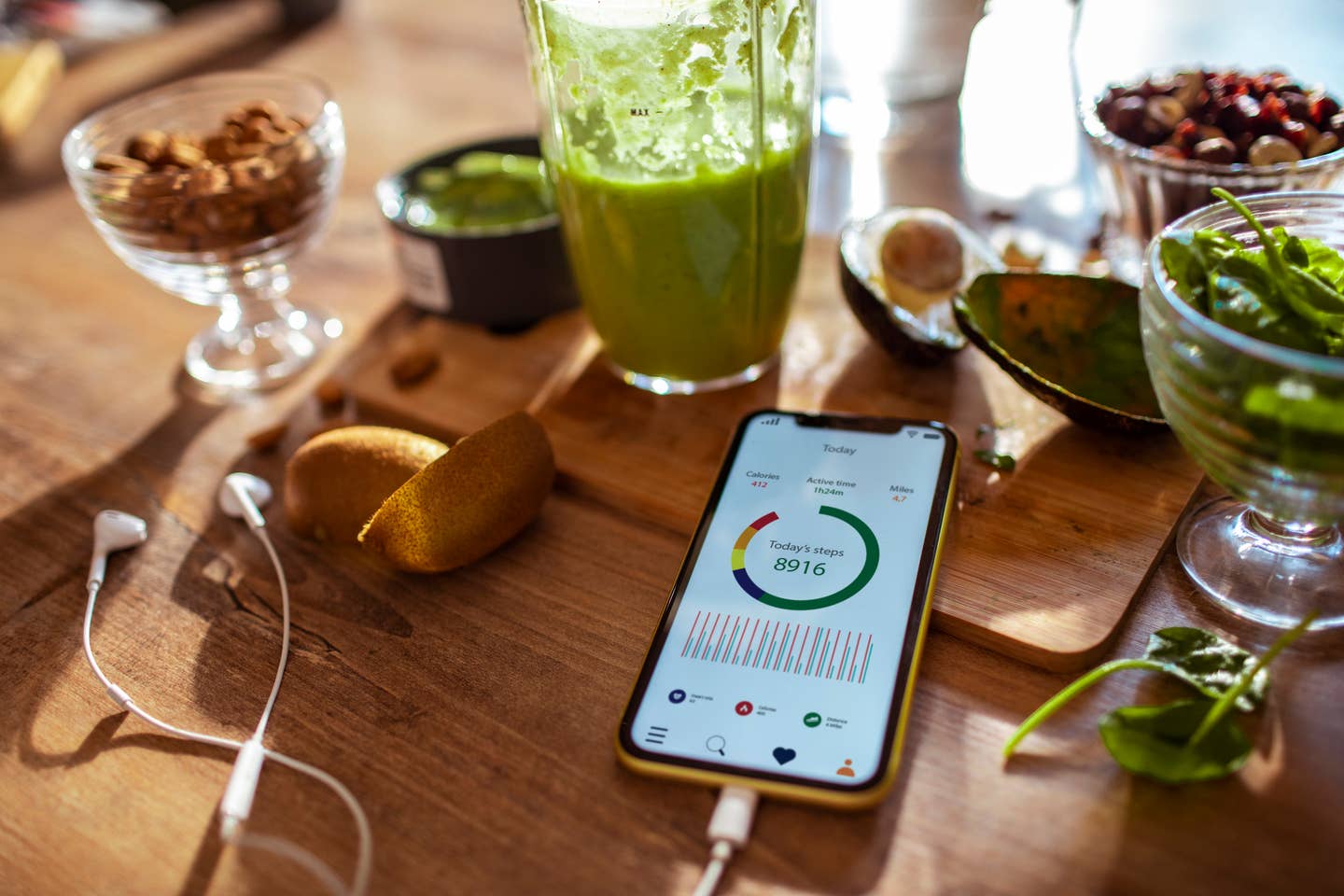
The 22 Best Foods to Lose Belly Fat, Lower Insulin Resistance, From a Doctor
If belly fat has you down, know this: There is likely a medical reason you're experiencing this stomach issue, and it's making it hard to lose weight. Once you know why you have belly fat, you can start to solve the problem, and it's not as difficult as you might think, according to scientific studies and experts like doctors who treat patients plagued with unwanted belly fat.
What Causes Belly Fat and How to Lose It
There's good news and bad news about belly fat. The bad news is that, according to a recent government estimate, no fewer than 88 percent of the US population is walking around with belly fat, and most likely it is a symptom of insulin resistance.
Insulin resistance is a condition that can lead to type 2 diabetes since your body essentially stops listening to your insulin response to food, which makes you produce even more insulin, and this cycle continues until you either change your diet and get healthy, or the insulin production, which is essentially stuck in the "on" position, short circuits and your pancreas begins to wear out, which is essentially the state in which diabetes starts to happen.
The good news about belly fat? There are dietary changes, specifically a plant-based high-fiber diet strategy, that can help you reverse insulin resistance to lose weight, shrink belly fat, and get back on the road to being your healthiest.
Why Is Belly Fat so Bad for Your Health?
Belly fat isn't just a vanity issue, but a sign of underlying health issues, which can become conditions that compromise your health, such as type 2 diabetes. So when belly fat shows up and acts stubborn, which it often does, and you find it hard to lose weight, you need to heed your doctor's advice and do something about it. That's the message from one MD we spoke to, who treats people with metabolic conditions, including obesity, diabetes, and insulin resistance. Here's how to get rid of belly fat.
By changing your diet, and adopting a low-carb, high-fiber approach by eating more vegetables, fruit, legumes, nuts, seeds, and whole grains (and less processed foods such as refined grains like added sugar and white flour foods), you can reverse metabolic syndrome, which is a condition that includes insulin resistance, this doctor's research has found.
Before you despair about what you can't eat, or how hard it is to lose weight and belly fat, there are 22 foods that have been scientifically shown to help fight belly fat, and can even reverse insulin resistance, if you eat them daily, and avoid simple carbs (such as sugar, crackers, chips, sweets, and other processed foods) that drive up blood sugar.
You can get rid of both belly fat and lower your insulin resistance, and achieve overall health, just by avoiding processed foods and adding these 22 foods to your diet, and it works even better if you exercise daily. First, cut out added sugar, animal fat, and processed or fast foods that are full of the types of simple carbs that cause insulin to spike in the first place.
What Is Insulin Resistance and How Can You Reverse It?
Insulin resistance is a term that describes what happens when your body "stops listening" to insulin, so you create more and more of it, in an effort to get blood sugar to safely be used by the cells or carted away to be stored as fat. Insulin resistance is especially hard to solve since once the extra fuel (whether it's sugar or fat) gets locked up, your blood sugar dips, and you sense that you're hungry – even though you just ate not too long ago – and you eat again to satisfy the hunger cue. Then insulin goes up again, and your cells resist the signal, and as insulin gets ignored (or resisted) it pumps more and more, until finally there's an answer.
Your blood can only hold a teaspoon of glucose or blood sugar at one time, so insulin is just trying to do its job to clear out the excess glucose before it can cause harm, but until you either fast or eat high-fiber foods, this ugly cycle continues, explains Dr. Cucuzzella, MD, author of the book Low-Carb on Any Budget. Insulin resistance–and excess belly fat–starts because your blood, all five liters of it, can only tolerate a finite amount of sugar in it, specifically the equivalent of a teaspoon or110 milligrams per deciliter, says Dr. Cucuzzella, who is a Family Medicine professor at West Virginia University School of Medicine.
When you eat more sugar or simple carbs (such as junk food, white bread, white pasta, sweets, chips or other highly processed foods) than your body can burn up by moving about, insulin response goes up, signaling to the body to store the extra fuel as fat. "Insulin knocks on the door" to tell your body that blood glucose needs to be delivered to the cells, first to the liver, muscles, and other cells, to be used for fuel, but then to your fat cells, where it can be stored till later."
Things go awry when you eat more sugar than you can use, he explains. The average American meal has about 60 to 75 grams of carbohydrates in it. On average Americans eat about 250 to 300 grams of carbs a day, which is about ten times what your body can use–unless you're training like an Olympic athlete. (Side note: Dr. Cucuzzella says he has eaten 20 to 30 grams of carbs a day for ten years, and as someone with diabetes, this level "keeps me well and running.")
The more carbs you eat, the more insulin is released, causing insulin resistance
If you throw the typical meal with those 60 to 75 grams of carbs, then your insulin is going to do whatever it has to do to store the extra. Instead of knocking on the door, it is now pounding on the door, to alert the body that there is too much blood sugar, and it has to do something to get the body's attention, so it starts rising and rising and rising. When those fat cells are full, the body says: enough! But insulin has to bang on the door even louder to get the body to listen and move that sugar out of our bloodstream."
This back-and-forth signaling (the insulin getting louder, bullying the body to store extra glucose as fat, the body resisting this message since it has had enough), sends insulin higher and higher, and the body becomes more and more resistant to the message. The body just does not want to hear from insulin again and again, like a spam caller. It stops picking up.
A better way to phrase it is carbohydrate intolerance, which means your body does not hear or see the insulin. Your body eventually acts the way someone who is gluten intolerant acts when they eat wheat: You get inflamed, your immune system overwhelmed, and your gut reacts as if all these carbs are making it sick, which in fact they are.
Whether you eat plant-based or not you have to be conscious of added sugar and simple carbs. If you were peanut-allergic, you can't eat them, but to someone who has central obesity, or who has insulin resistance, they are essentially carb allergic.
Only 12 percent of the population is "metabolically well," Dr. Cucuzzella says, and for the other 88 percent with metabolic conditions, eating foods that help lower blood sugar is the key to shedding that unwanted belly fat, lowering the volume on insulin, and getting healthier.
What Is Metabolic Syndrome?
"The primary driver of belly fat and insulin resistance is excess sugar in the bloodstream, which comes from the food we eat," such as excess carbohydrates, causing insulin resistance and creating a “metabolic storm” inside our bodies," Dr. Cucuzzella explains.
As the metabolism breaks down, people develop a condition called metabolic syndrome, a cluster of conditions, which together act to increase your risk of heart disease, stroke, nonalcoholic fatty liver disease, and type 2 diabetes.
Given the implications associated with these conditions (increased blood pressure, high blood sugar, excess body fat around the waist, and a high cholesterol profile ), Dr. Cucuzzella has written an article, "Is It Time for a Lockdown on Sugar?," published in the current issue of Clinical Journal of Sports Medicine.
Why is Belly Fat Dangerous?
Belly fat is more than just a cosmetic issue, he adds: "Belly fat or abdominal fat is the dangerous fat," Dr. Cucuzzella says. "It's called visceral fat, not brown body fat. We need brown fat as protection for vital storage. Women store differently than men, and more for endocrine function and for reproduction. But when you store it in the abdomen it increases the risk of heart disease and stroke. The primary driver of that apple shape is metabolic syndrome.
"Of the patients I see, 90 percent of them have it and they don't know it. Essentially the body does not metabolize carbs the way it should. When you look at glucose per deciliter of concentration, they may not even eat more carbs than other people by the time they come to see me, but their body has become intolerant of the carbs they do eat."
The problem is that if the liver is already filled and your muscles are filled (with the energy they need) and then you add more carbs and fat to the blood and over time, you have liver fat. . So not just sugar but the fat that comes with it, so now you have fat trapping. Insulin is a switch, which says store. So if you need to use that fat as fuel you need to reduce carbs and you can do that with a mostly plant-based diet.
Carbs are the primary driver of insulin. So to do this you have to lower insulin and if you do that you need to lower carbs. It's not going to go away with a 30-day diet, he explains. Instead, the answer is to change your way of eating and to approach it as a lifestyle. You have to make that switch.
Reverse Metabolic Syndrome and Lose Belly Fat
The number one thing that Dr. Cucuzzella recommends to his patients is to follow a diet of low-carb, high-fiber foods, and to stick to eating real or whole foods. By doing this, it's possible to lose belly fat and ultimately succeed at lasting weight loss.
"It's really not anything extreme. It's what your grandmother would eat: Nothing in a box or a bag with a label. Plenty of real food with carbs, but also high in fiber, so while a banana would qualify, it will behave differently in the body than leafy vegetables."
Eating a diet high in fiber and low in carbs is the best way to combat and reverse insulin resistance, Dr. Cucuzzella says. Choose carbs that have fiber, like green leafy vegetables, and focus on getting as many of these high-fiber foods as you can, while cutting out the simple sugars and starchy foods.
"Fiber is magical. What fiber does is feeds the gut. Take zucchini for example. It might have six grams of carbs but 2 grams of that is fiber. That means the carbs in zucchini are not behaving like glucose in the body. The fiber will become food for the healthy bacteria in our gut. The same thing is true if I eat an apple, the carbs behave differently than apple juice with no fiber. Fiber feeds the healthy trillions of bacteria in the gut and helps to fight obesity and heart disease, and it makes you feel full.
"We don't understand all the ways that the microbiome helps keep us healthy," says Dr. Cucuzella, "but we know that feeding it vegetables, and high-fiber foods such as greens, can help reverse disease and lower insulin. Simply said, eat fiber, in the colors of the rainbow, to provide nourishment to the microbiome and lower your insulin response to the food you eat."
Why It’s So Important to Eat Fewer Simple Carbs
Carbs create inflammation explains Dr. Cucuzzella, which is dangerous when you get sick from the flu or other virus. "I work in a hospital so people in the hospital often have these conditions associated with insulin resistance, which is obesity and hypertension, and diabetes. If you want to protect yourself from the flu or the next wave of COVID-19, get healthy now. You can lower the chances of having complications or severe symptoms if you get healthy now by maintaining a low-carb diet.
"If you are ever in hospital you need to have the host or body be healthy to fight the infection. The cytokine storm causes hyperglycemia. And when we have hyperglycemia our whole immune system function is disabled and it starts a cascade of negative effects. We don't have a good treatment for the cytokine storm yet. You have to ride it out. The people who have it the worst are people with some spectrum of high blood sugar or metabolic syndrome."
The 22 foods to eat to help lower insulin resistance
Here is Dr. Cucuzzella's list of non-starchy plant foods that he gives to his patients, from his book, Low Carb on Any Budget. It should not be expensive to eat healthily. He calls it the Green Food list. Eat these to help lower insulin resistance and lose stubborn belly fat.
- Avocado
- Asparagus
- Bell Pepper
- Brussels Sprouts
- Cabbage
- Cauliflower
- Cucumber
- Green Onions
- Jalapeño
- Mushrooms
- Olives
- Onion
- Pickles
- Romaine Lettuce
- Spinach
- Sauerkraut
- Tomatoes
- Zucchini
- Macadamia Nuts
- Almonds
- Walnuts
- Pecans
Bottom Line: Stubborn Belly Fat Could Be a Sign of Insulin Resistance. Here Are 22 Foods to Fight Back
Belly fat may be a sign that you are battling with insulin resistance, a potentially dangerous condition that can lead to diabetes, according to this doctor. To fight back and get rid of stubborn belly fat, and reverse your insulin resistance, eat these 22 foods that are part of a high-fiber diet rich in vegetables, legumes, fruit, and whole grains, and avoid highly-processed foods that cause insulin levels to spike.
For more ways to incorporate a healthy, plant-based diet into your life, check out The Beet's Health and Nutrition articles.
You may think iron is synonymous with meat, and while animal protein certainly has it, that doesn’t mean you can’t get enough iron if you eat a mainly plant-based diet. In fact, you can, if you know the right foods to choose and how to pair them. The daily recommendation from the National Institutes of Health (NIH) for iron intake is 18 milligrams (mg), but not all iron sources are created equal. Here’s what plant-based eaters need to know about iron and which iron-rich foods are best to help reap the benefits.
1. White Mushrooms
1 cup cooked = 3 mg iron (17% daily value (DV))\There are many reasons to eat mushrooms on the regular, but their meaty texture (try a Portobello cap as a meat replacement for a burger!) and ample protein are two of the highlights. Add them to your stir-fry, tacos, or even instead of meat in a faux Bolognese sauce.
2. Lentils
1/2 cup = 3 mg iron (17% DV)You don’t need to eat a huge serving of lentils to get a hearty dose of iron. Just a half-cup provides close to 20% of the iron you need in a day. Just like mushrooms, lentils have a meaty texture that works well in burgers, tacos, or grain bowls.
3. Potatoes
1 medium potato = 2 mg iron (11% DV)The poor potato has gotten such a bad rap. Fear of this carb-rich spud is unwarranted because it’s actually an affordable and delicious source of iron and potassium. So go ahead and have that hash, baked potato, or potato soup and leave the skin on for some added fiber.
4. Cashews
1 ounce = 2 mg iron (11% DV)Most nuts contain iron, but cashews are a standout because they have less fat than some of the other nuts. One ounce of cashews (about 16 to 18 nuts) has 160 calories, 5 grams of protein, and 13 grams of fat. Add a handful of cashews to smoothies, soups, or sauces for some extra creaminess.
5. Tofu
½ cup = 3 mg (15% DV)Not only does tofu have plenty of protein and calcium, but it’s also a good source of iron. It’s very versatile and takes on the flavor of any sauce or marinade, making it a great meat substitute.Keep in mind that you can easily get the iron you need from a plant-based diet.
More From The Beet






